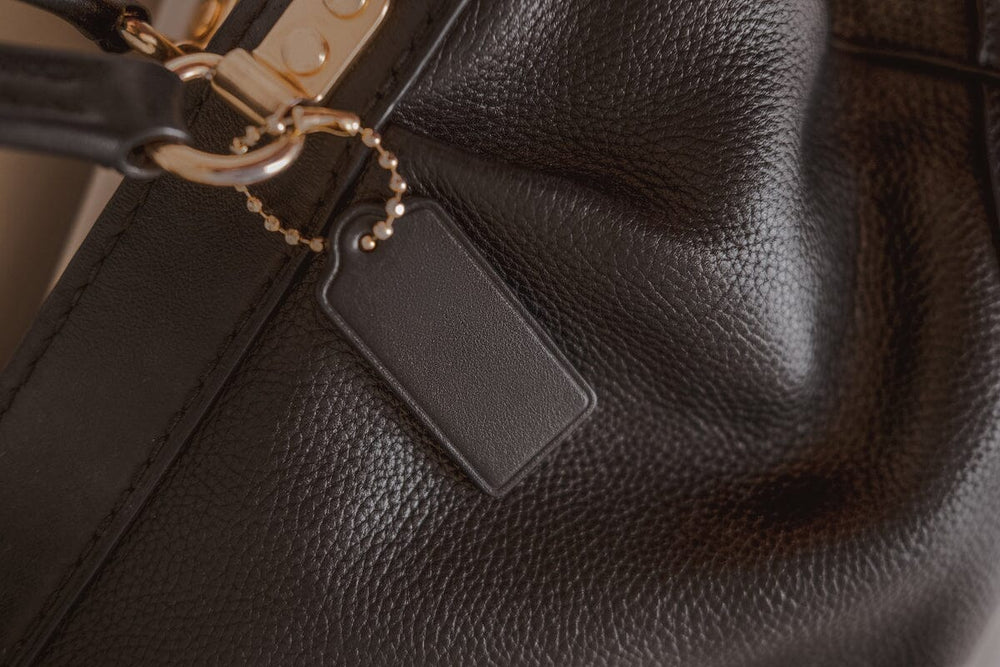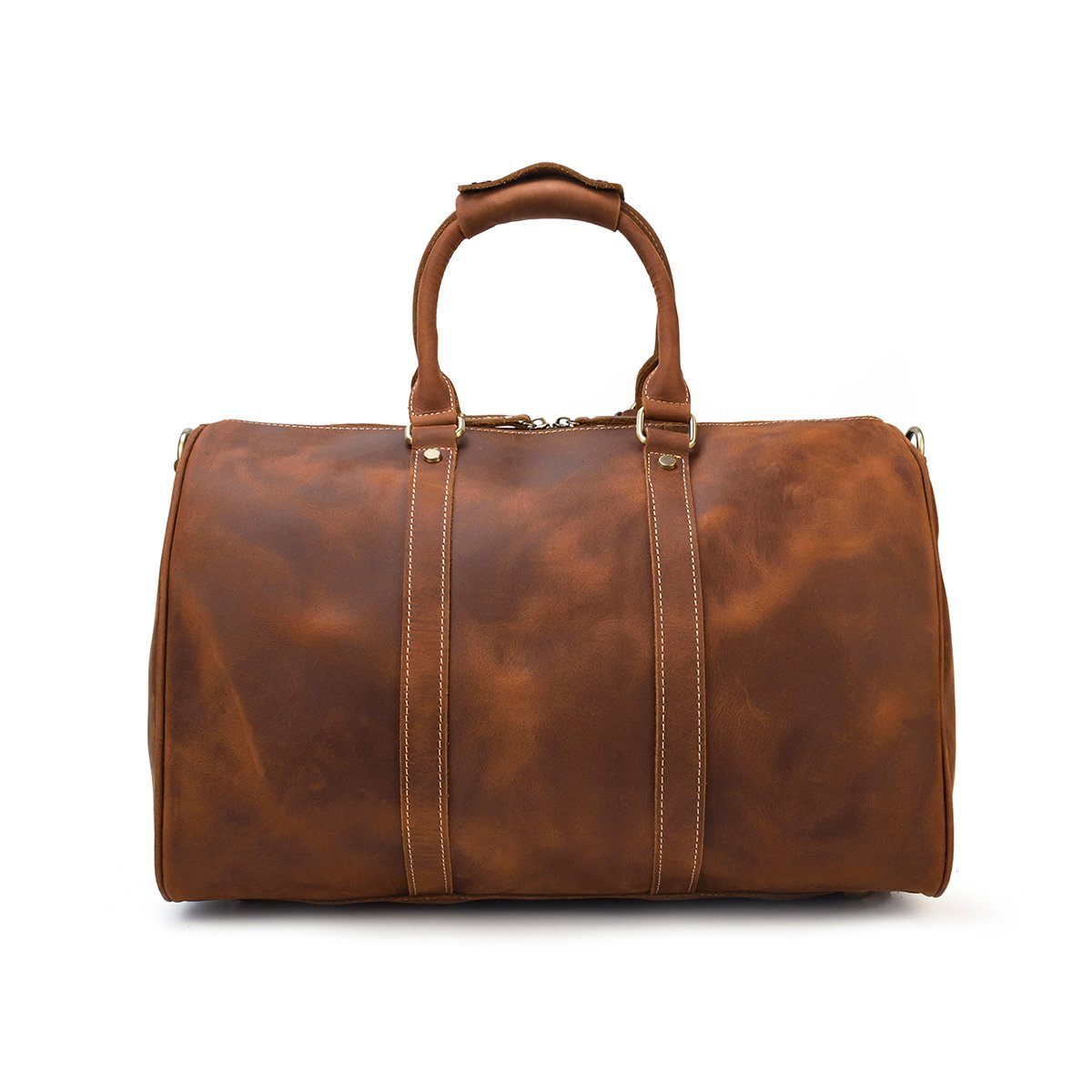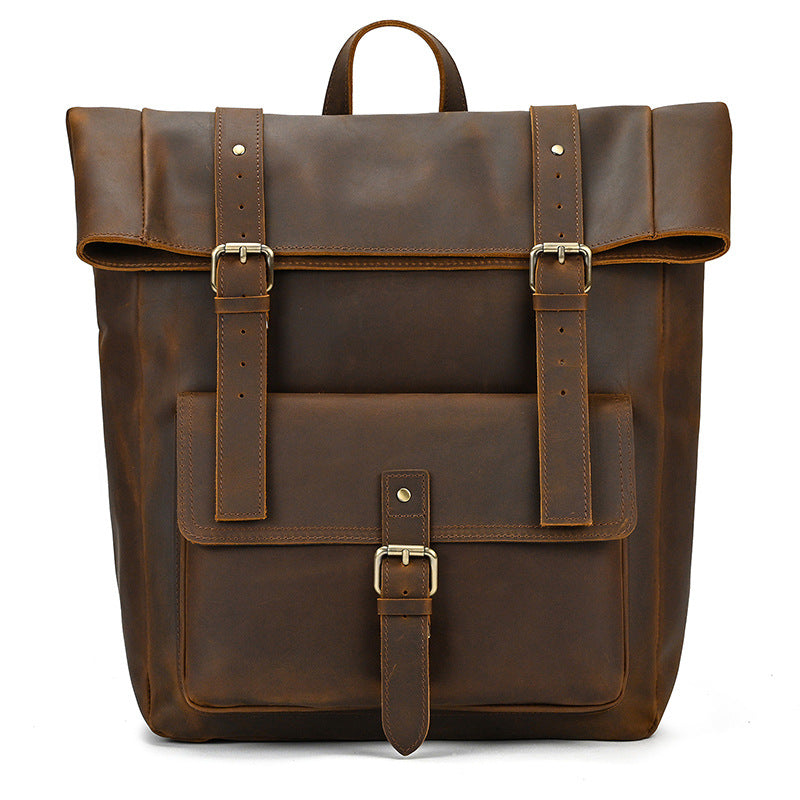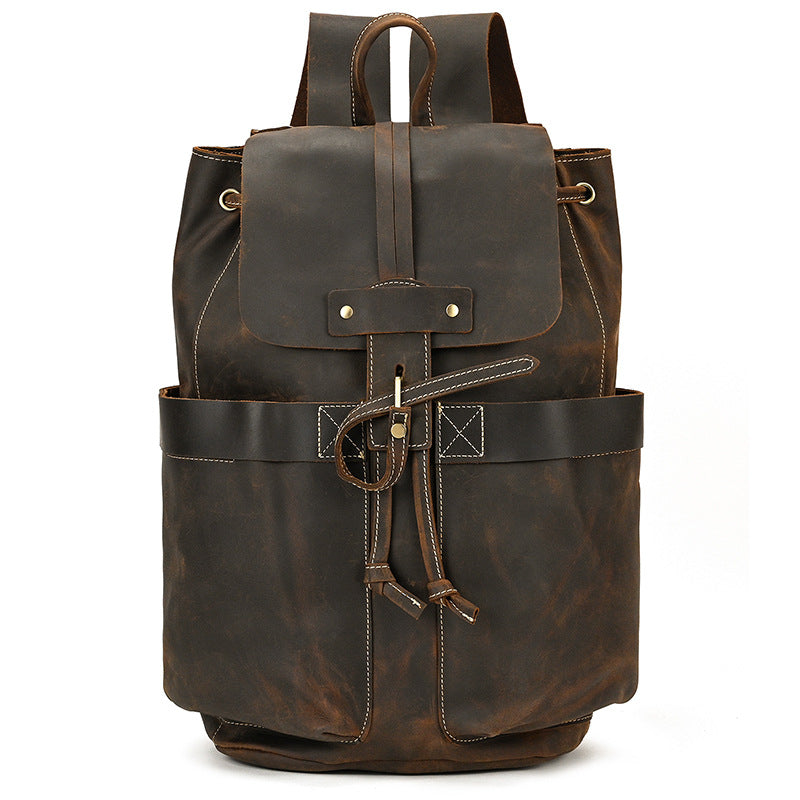
What is Pebbled Leather? A Comprehensive Exploration
Reading Time: about
Are you a fan of leather goods? If so, you've probably come across pebbled leather at some point in your shopping adventures. But what exactly is pebbled leather, and what makes it so special?
In this blog post, we'll explore the world of pebbled leather, covering everything from its unique texture and manufacturing process to tips on how to care for and repair your pebbled leather items.
So, buckle up and join me on this fascinating journey into the world of this much-loved material!
Summary
- 1. What is Pebbled Leather?
- 2. Where Does Pebbled Leather Come From?
- 3. What are the Different Types of Pebbled Leather?
- 4. How Genuine Pebbled Leather is Made?
- 5. How Faux Pebbled Leather is Made?
- 6. How to Identify Quality Pebbled Leather?
- 7. How to Clean & Care for Pebbled Leather?
- 8. How to Fix Tears in Pebbled Leather?
- 9. How to Fix a Scratch on Pebbled Leather?
- 10. Which Popular Brands Use Pebbled Leather?
- 11. Related FAQ
I. What is Pebbled Leather?
As a leather aficionado, I have always been fascinated by the various textures and finishes that leather can have. One such finish that has captured my attention and admiration is pebbled leather. So, what exactly is pebbled leather? It is a type of leather that features a distinct, raised pattern that resembles small pebbles on its surface. This unique texture is created during the manufacturing process, giving the leather an attractive, luxurious, and tactile quality.
My first encounter with pebbled leather was at a local boutique when I stumbled upon a gorgeous handbag that had this distinctive texture. I was immediately drawn to its beauty, and since then, I have been on a quest to learn more about pebbled leather and its many applications.
Pebbled leather has been a popular choice for high-end fashion accessories for years, and it's not hard to see why. The texture adds depth and visual interest to a wide variety of products, from handbags and wallets to shoes and belts. Moreover, pebbled leather is known for its increased durability and resistance to wear and tear, making it a practical choice for items that see everyday use.
II. Where Does Pebbled Leather Come From?
My fascination with pebbled leather led me to explore its history, and I discovered that the technique can be traced back to the early 1900s. At that time, leather manufacturers were constantly seeking ways to make their products stand out from the competition, and pebbled leather emerged as an innovative solution.
The distinctive texture of pebbled leather quickly gained popularity for its stylish appearance and enhanced durability. Over the years, the technique has been refined and perfected, and today, pebbled leather is highly sought after for its timeless appeal and enduring quality.
The popularity of pebbled leather has also led to the development of various types and grades of this material, each with its own unique characteristics and applications. From full-grain and top-grain pebbled leather to genuine and faux alternatives, there's a wide range of options available to cater to different preferences and budgets.
III. What are the Different Types of Pebbled Leather?
As I delved deeper into the world of pebbled leather, I discovered that there are several different types and grades of this material available, catering to a wide range of tastes and budgets. Here are the main types of pebbled leather you might encounter:
1. Full-grain pebbled leather
Full-grain pebbled leather is considered the highest quality type of pebbled leather, as it is made from the top layer of the hide, which contains all the natural grain patterns. This type of pebbled leather is prized for its strength, durability, and breathability, making it an excellent choice for high-end fashion accessories and luxury goods.
When I first got my hands on a full-grain pebbled leather handbag, I was amazed by the richness of its texture and the depth of its color. It is definitely a material that exudes elegance and sophistication, making it well worth the investment.
2. Top-grain pebbled leather
Top-grain pebbled leather is another popular option, and it is created by removing the outermost layer of the hide, which contains the natural grain patterns. This type of pebbled leather is slightly thinner and more pliable than full-grain leather, but it still retains a high level of durability and quality.
Top-grain pebbled leather is often used for mid-range fashion accessories, and it offers a more affordable alternative to full-grain pebbled leather without compromising on style or longevity.
3. Genuine pebbled leather
Genuine pebbled leather is a more budget-friendly option, created from the lower layers of the hide, which are split from the top-grain layer. This type of pebbled leather is more affordable due to its lower quality, and it may not be as durable or as breathable as full-grain or top-grain pebbled leather.
That said, genuine pebbled leather can still be a stylish and practical choice for those on a budget, offering a reasonable level of quality at a more accessible price point.
4. Faux pebbled leather
For those who prefer a vegan or eco-friendly alternative, faux pebbled leather is an option worth considering. This type of pebbled leather is made from synthetic materials, such as polyurethane or PVC, and is designed to closely mimic the appearance and feel of genuine pebbled leather.
While faux pebbled leather may not offer the same level of durability or breathability as genuine leather, it can still be a stylish and cruelty-free choice for those who prioritize ethical and environmental considerations.
In my experience, the quality of faux pebbled leather can vary greatly depending on the brand and manufacturing process, so it's essential to do your research and choose a reputable supplier if you decide to go down this route.
IV. How Genuine Pebbled Leather is Made?
My curiosity about pebbled leather didn't stop at its history; I also wanted to understand how this unique material is created. The process of making pebbled leather involves several key steps, which I'll outline below.
1. Raw material selection
The first step in creating pebbled leather is the selection of high-quality raw materials. Manufacturers typically choose top-notch hides, usually sourced from cows, to create the perfect base for pebbling. These hides are carefully inspected to ensure that they are free from defects and imperfections, which could affect the final appearance and quality of the pebbled leather.
2. Tanning and dyeing
Once the raw materials have been selected, they undergo a crucial tanning and dyeing process. This step is essential for transforming the raw hides into soft, supple, and durable leather that is ready for embossing. The tanning process typically involves treating the hides with various chemicals and agents, which help to preserve the leather and give it its signature color.
After tanning, the leather is dyed using a range of techniques, such as drum dyeing or hand dyeing, to achieve a rich, even color. This stage is vital for ensuring that the final pebbled leather product has a beautiful and consistent hue.
3. Pebbling technique
The final step in creating pebbled leather is the embossing of the pebbled pattern onto the surface of the leather. This is typically done using specialized embossing plates or rollers, which feature the desired pebble pattern. The leather is first softened and prepared for embossing, usually by applying heat and moisture. Once the leather is ready, it is placed between the embossing plates or fed through the embossing rollers, which apply pressure to imprint the pebble pattern onto the surface.
The embossing process requires precision and skill, as the pressure and heat must be carefully controlled to create a consistent and attractive pebbled texture. The end result is a stunning and distinctive material that boasts a delightful tactile quality and enhanced durability.
📷 Credit: Optima Leathers's Youtube Channel
V. How Faux Pebbled Leather is Made?
Faux pebbled leather, a popular alternative to genuine pebbled leather, is created using synthetic materials designed to closely mimic the appearance and texture of real leather. Here's an overview of the process involved in making faux pebbled leather:
-
Material selection: The most common materials used for faux pebbled leather are polyurethane (PU) and polyvinyl chloride (PVC). Both materials are lightweight, flexible, and can be easily manipulated to resemble genuine leather.
-
Surface treatment: The chosen synthetic material is treated with a range of chemicals and dyes to achieve the desired color, texture, and finish. This treatment process can also include the addition of a protective coating to enhance durability and water resistance.
-
Embossing: To create the pebbled texture, the synthetic material is embossed using specialized plates or rollers, much like the process used for genuine pebbled leather. The material is fed through the embossing rollers or pressed between the embossing plates, imprinting the pebble pattern onto the surface.
-
Final touches: Once the faux pebbled leather has been embossed, it undergoes additional treatments and finishing processes to ensure that it closely resembles genuine pebbled leather. This may include adding a subtle sheen or applying a topcoat for added durability and resistance to wear.
📷 Credit: fabrication.Workmanship's Youtube Channel
VI. How to Identify Quality Pebbled Leather?
As a lover of pebbled leather, I've learned that it's crucial to recognize the signs of high-quality pebbled leather to ensure that you're getting the best value for your money. Here are some key factors to consider when assessing the quality of pebbled leather products:
1. Texture
One of the most obvious indicators of quality pebbled leather is its texture. High-quality pebbled leather should have a consistent and well-defined pebble pattern, with each "pebble" being distinct and clearly visible. If the texture seems irregular, uneven, or poorly defined, it could be a sign that the leather is of lower quality.
When I'm shopping for pebbled leather items, I always take the time to closely examine the texture, running my fingers over the surface to ensure that it feels smooth, uniform, and pleasing to the touch.
2. Durability
Quality pebbled leather should be highly durable, with a strong resistance to wear and tear. One way to assess the durability of pebbled leather is to look for signs of wear, such as scuffs, scratches, or fading, on items that have been used for a while. High-quality pebbled leather should show minimal signs of wear and should maintain its beautiful appearance over time.
I remember when I bought my first pebbled leather wallet, which has been with me for several years now. Despite daily use, it still looks great and has held up remarkably well, which I attribute to its high-quality pebbled leather construction.
3. Scent
Another factor to consider when assessing the quality of pebbled leather is its scent. Genuine, high-quality pebbled leather should have a natural, pleasant smell that is reminiscent of leather, not chemicals or synthetic materials. If you detect an unpleasant or overly strong chemical odor, it could be a sign that the leather is of lower quality or has been treated with inferior chemicals during the tanning and dyeing process.
4. Stitching and construction
In addition to examining the leather itself, it's also essential to pay attention to the stitching and construction of pebbled leather products. High-quality items should feature tight, even stitching, with no loose threads or signs of fraying. The construction should be sturdy and well-executed, with neatly finished edges and high-quality hardware.
By keeping these factors in mind, you can ensure that you're investing in high-quality pebbled leather products that will stand the test of time and provide you with years of enjoyment and satisfaction.
VII. How to Clean & Care for Pebbled Leather?
One of the things I love most about pebbled leather is its low-maintenance nature, which makes it an ideal choice for busy individuals like myself. However, proper care and maintenance are still essential to ensure the longevity of your pebbled leather items. Here are some tips I've learned over the years to keep my pebbled leather belongings in top-notch condition:
1. Cleaning
To clean your pebbled leather items, it's best to use a gentle spot cleaning technique. Simply dampen a soft cloth with water and a small amount of mild soap, and gently rub the soiled area in a circular motion. Be sure to avoid using harsh chemicals or abrasive materials, as these can damage the leather's surface.
2. Conditioning
Regular conditioning is key to maintaining the suppleness and appearance of your pebbled leather items. Apply a high-quality leather conditioner every few months, following the manufacturer's instructions, to keep your leather looking and feeling its best. Be sure to choose a conditioner that is specifically formulated for pebbled leather to ensure optimal results.
3. Storage
Proper storage is essential to prevent damage to your pebbled leather items. When not in use, store your leather products in a cool, dry place away from direct sunlight, which can cause fading or cracking. It's also a good idea to use a dust bag or protective cover to shield your items from dust, moisture, and potential scratches.
For items such as handbags or shoes, consider using a supportive insert or tissue paper to help maintain their shape while in storage. This can prevent creasing and deformation, ensuring that your pebbled leather items remain in great condition for years to come.
📷 Credit: Poppy Barley's Youtube Channel
VIII. How to Fix Tears in Pebbled Leather?
Fixing tears in pebbled leather can be a delicate process, but with the right tools and techniques, it is possible to repair the damage and restore the appearance of your leather item. Here's a step-by-step guide on how to fix tears in pebbled leather:
-
Clean the area: Begin by cleaning the area around the tear with a damp cloth and a small amount of mild soap. Ensure that the area is free of dirt and debris, and allow it to dry completely.
-
Insert a leather repair patch: Cut a piece of leather repair patch slightly larger than the tear and carefully insert it behind the tear, using tweezers if necessary. The patch should be adhesive-backed, ensuring that it stays in place and provides support for the repair.
-
Apply leather repair compound: Using a palette knife or spatula, apply a thin layer of leather repair compound to the tear, spreading it evenly and ensuring that it fills the gap between the torn edges.
-
Texture the repair: To replicate the pebbled texture, place a textured paper or a piece of plastic wrap over the repair compound while it's still wet. Press gently to imprint the texture onto the compound, and then carefully remove the paper or plastic wrap.
-
Allow to dry: Allow the repair compound to dry completely, following the manufacturer's instructions for the recommended drying time.
-
Color matching: Once the repair compound is dry, use a leather dye or colorant to match the color of your pebbled leather item. Apply the dye or colorant according to the manufacturer's instructions, and allow it to dry completely.
-
Apply a protective topcoat: To seal and protect the repair, apply a clear leather topcoat, ensuring that it is compatible with pebbled leather. Allow the topcoat to dry fully before using your repaired leather item.
IX. How to Fix a Scratch on Pebbled Leather?
Minor scratches on pebbled leather can often be fixed using a simple and straightforward process:
- Clean the area: Gently clean the scratched area with a soft, damp cloth and mild soap. Allow the area to dry completely before proceeding.
- Apply leather conditioner: Using a clean cloth, apply a small amount of leather conditioner specifically formulated for pebbled leather to the scratched area. Gently rub the conditioner into the scratch using a circular motion, taking care not to apply too much pressure.
- Buff the scratch: Continue to gently buff the scratched area until the scratch fades and blends with the surrounding leather. This may take several minutes of gentle rubbing, so be patient and persistent.
- Allow to dry: After the scratch has been sufficiently buffed and blended, allow the leather conditioner to dry completely before using or handling the item.
- Apply a protective topcoat: As a final step, you may wish to apply a protective topcoat specifically designed for pebbled leather to help prevent future scratches and maintain the leather's appearance.
X. Which Popular Brands Use Pebbled Leather?
Many popular brands and designers incorporate pebbled leather into their collections due to its unique texture, durability, and timeless appeal. Some well-known brands that use pebbled leather in their products include:
-
Coach: A leading luxury brand, Coach offers a wide range of pebbled leather items, including handbags, wallets, and accessories.
-
Tory Burch: Known for its stylish and sophisticated designs, Tory Burch features pebbled leather in many of its handbags, shoes, and accessories.
-
Michael Kors: As a prominent designer brand, Michael Kors incorporates pebbled leather into its collections, offering various handbags, wallets, and other leather goods.
-
Fossil: Specializing in vintage-inspired designs, Fossil uses pebbled leather in many of its products, including watches, handbags, and wallets.
-
Kate Spade: With its playful and chic aesthetic, Kate Spade frequently includes pebbled leather in its handbag and accessory collections.
By choosing pebbled leather items from these reputable brands, you can be confident that you're investing in high-quality products that will stand the test of time and remain stylish for years to come.
📷 Credit: classicswithaquirk's Youtube Channel
Wrapping Up
Pebbled leather is a versatile and stylish material that adds a touch of luxury and sophistication to a wide range of fashion accessories and products. Its unique texture, combined with its durability and low-maintenance nature, makes it an attractive choice for those seeking high-quality leather goods.
By understanding the different types of pebbled leather, recognizing the signs of quality, and learning how to care for your pebbled leather items, you can make informed decisions when shopping for leather products and ensure that you're investing in items that will stand the test of time.
Now that you're armed with this comprehensive guide to pebbled leather, you can confidently explore the world of pebbled leather goods and indulge in the timeless appeal of this exceptional material.
Related FAQ
What is pebbled leather made from?
Pebbled leather is typically made from cowhide, which is known for its durability and versatility. The pebbled texture is created during the manufacturing process, using specialized embossing plates or rollers to imprint the distinctive pattern onto the surface of the leather.
Is pebbled leather waterproof?
Pebbled leather is not inherently waterproof, but it does have a natural resistance to moisture due to its textured surface. To further protect your pebbled leather items from water damage, you can use a leather protectant spray specifically designed for pebbled leather.
How can I remove scratches from my pebbled leather items?
Minor scratches on pebbled leather can often be buffed out using a soft, clean cloth and a small amount of leather conditioner. Gently rub the scratched area in a circular motion until the scratch fades. For more severe scratches or damage, it's best to consult a professional leather repair service.
Can I use regular leather cleaner and conditioner on pebbled leather?
It's best to use products specifically formulated for pebbled leather to ensure optimal results. Using a regular leather cleaner or conditioner may not be as effective, and it could potentially cause damage to the pebbled texture.
How can I tell if my pebbled leather item is genuine or faux?
Genuine pebbled leather typically has a natural, pleasant scent, whereas faux pebbled leather may have a strong chemical or synthetic odor. Additionally, genuine leather will usually have a more consistent and well-defined pebble pattern, whereas faux leather may appear less uniform and authentic
Can pebbled leather be vegan or cruelty-free?
Yes, faux pebbled leather is an alternative to genuine pebbled leather and is typically made from synthetic materials like polyurethane (PU) or polyvinyl chloride (PVC). Faux pebbled leather is considered vegan and cruelty-free, as it does not involve the use of animal-derived materials.
Can I use the same care products on pebbled leather as smooth leather
While some care products may be suitable for both smooth and pebbled leather, it's essential to read the label and make sure the product is specifically recommended for pebbled leather. Some formulations may not be compatible with the textured surface, potentially causing damage or undesirable effects.
📫 Related Blog Posts:
📌 Mastering Leather Repair: A Complete Guide for Longevity
📌 What are Aniline Leather & Semi-Aniline Leather?
📌 What is Latigo Leather? [Complete Guide]
📌 What is Shell Cordovan ? The Timeless Elegance of a Premium Leather
📌 How to Clean Mold Off Leather? [Step-by-Step Guide]
📌 What is Goat Leather? A Comprehensive Guide From Farm to Fashion
📌 The Beauty of Burnished Leather: Why It's Timeless and Popular?
📌 What is Split Leather? From History to Care Tips and Beyond
📌 What is Tooling Leather? A Comprehensive Guide
📌 What is Leather Tanning? A Journey from Hide to Product
📌 How to Remove Ink from Leather? Master the Art of Leather Cleaning





















Leave a comment